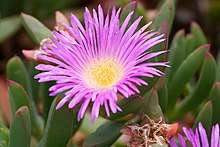Carpobrotus aequilaterus
Carpobrotus aequilaterus, common names: angled pigface, Chilean pigface,[3] is native to Chile,[4][3], and a naturalised weed elsewhere. However, according to VicFlora it is native to South Africa, and according to Plants of the World Online[5] it is native to Australia, but this last can be discounted as no Australian botanical site considers it to be a native. [3][6] [7] It is also known as the sea fig.
| Carpobrotus aequilaterus | |
|---|---|
 | |
| Scientific classification | |
| Kingdom: | Plantae |
| Clade: | Tracheophytes |
| Clade: | Angiosperms |
| Clade: | Eudicots |
| Order: | Caryophyllales |
| Family: | Aizoaceae |
| Genus: | Carpobrotus |
| Species: | C. aequilaterus |
| Binomial name | |
| Carpobrotus aequilaterus | |
The plant grows along the coast from sea level and up to 100 metres higher. It can be found in Chile, California, Mexico, and Australia. It is a naturalised weed in North America, New Zealand, and Australia [3] (in New South Wales, [6] Tasmania, Victoria, South Australia), [3] and Western Australia).[8]
Description
Carpobrotus aequilaterus has an edible fruit. The flavour is said to be like strawberry but they have a poor structure. The flowers are pollinated by bees although the flowers are hermaphrodite. The plants grow from 8 to 72 inches high.[9]
References
- "Carpobrotus aequilateralus". Australian Plant Name Index (APNI), IBIS database. Centre for Plant Biodiversity Research, Australian Government. Retrieved 22 November 2018.
- Brown, N.E. (1928) Journal of Botany, British and Foreign 66: 324
- eFloraSA: Electronic Flora of South Australia species factsheet: Carpobrotus aequilaterus
- "Doca o Frutilla de Mar". 2009.
- Govaerts, R. et. al. (2018) Plants of the world online: Carpobrotus aequilaterus. Board of Trustees of the Royal Botanic Gardens, Kew. Retrieved 22 November 2018.
- PlantNET: Carpobrotus aequilaterus
- VicFlora Flora of Victoria: Carpobrotus aequifolius
- "Carpobrotus aequilaterus". FloraBase. Western Australian Government Department of Parks and Wildlife.

- Carpobrotus aequilaterus - (Haw.) N.E.Br. Plants for a Future. Retrieved 22 November 2018.